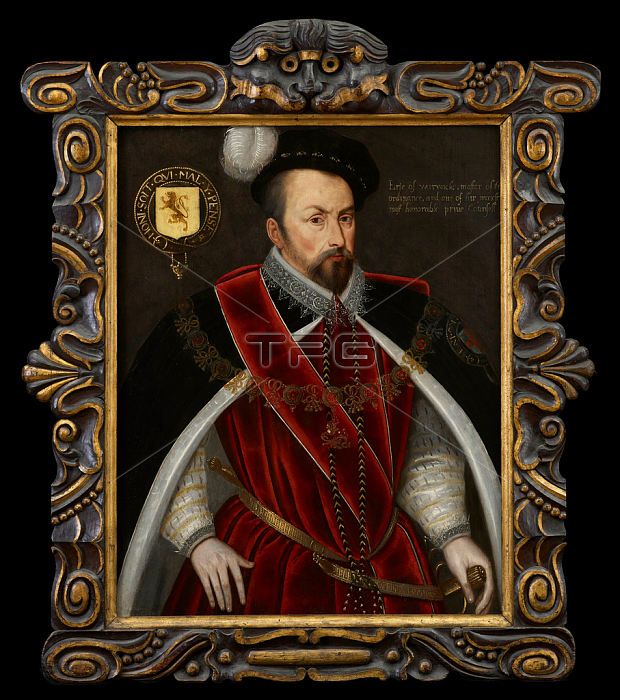
5322329 Ambrose Dudley, Earl of Warwick, late 1590s (oil on panel) by English School, (16th century); 85x51 cm; Private Collection; (add.info.: Ambrose Dudley, Earl of Warwick (c.1530-90) This vibrant late-Elizabethan panel portrait of Ambrose Dudley, Earl of Warwick was until recently obscured by several layers of discoloured varnish and later overpaint. Now removed, it is clear that this work is by the same hand or workshop that produced a portrait of Ambrose??? brother Robert in the collection of the Yale Center for British Art [B1975.1.7]. Furthermore, the fact that both these works bear the same Cure family wax seal on the reverse confirms they were both at one time part of the same collection and almost certainly hung together, possibly as part of a larger set of portraits of Garter knights. As with most chivalric orders, membership of the Order of the Garter, which was reputedly founded by King Edward III, was limited, in this case to just twenty-five knights not including the sovereign. The annual procession and feast, immortalised in Gheeraerts??engraving from 1576 [British Museum], helped to strengthen the sense of unity between the knights and their sovereign and likewise, the process of expulsion, reserved for those who rebelled, was equally public. Although in later life Ambrose may have exemplified the type of loyal, trustworthy supporter whom Elizabeth was so keen to cultivate, his early life was quite different, and in 1553, follow-ing the disastrous attempt to establish Lady Jane Grey as queen, Ambrose was imprisoned in the tower accused of treason and sentenced to death. Lady Jane Grey was married to Am-brose??? brother Guildford Dudley, a marriage arranged by their father John Dudley, 1st Duke of Northumberland, chief advisor to Edward VI. Although things went relatively smoothly to start with, support soon swayed in favour of Mary Tudor and in July 1553 Ambrose, along with his father John, surrendered in Cambridge and both were arrested. Unlike his father John and brother Guildford, Ambrose, along with his brothers Henry and Robert, were spared execution and in January 1555 were pardoned though remained attainted. It was only after his service in the battle at St. Quentin in 1557 that the attainder against Ambrose was repealed, although all claims for his father??? es-tates and titles had to be forfeited. Ambrose??? relationship with Elizabeth on her accession was considerably more stable, and in early 1559 he was granted the manor of Knebworth Beauchamp in Leicestershire and was ap-pointed Master of the Ordnance. On 25 December 1561 Dudley was created Baron Lisle and then, the next day, was made Earl of Warwick. That same year he was given Warwick Castle as well as several other wealthy estates. In 1563 Warwick was made a Knight of the Garter and his later success against the rebels during the Northern Rebellion in 1569 ensured a comfortable end to his long career. As well as receiving further estates, he was made chief butler of England and in 1573 appointed to the Privy Council. By the 1580s, however, Ambrose??? health was in decline, caused in no small part by a leg injury he had sustained in Le Havre some years earlier, and on 21 February 1590, a few weeks after his leg was amputated, he died.); Photo by Philip Mould Ltd, London.
| px | px | dpi | = | cm | x | cm | = | MB |
Details
Creative#:
TOP27752846
Source:
達志影像
Authorization Type:
RM
Release Information:
須由TPG 完整授權
Model Release:
No
Property Release:
No
Right to Privacy:
No
Same folder images:

 Loading
Loading